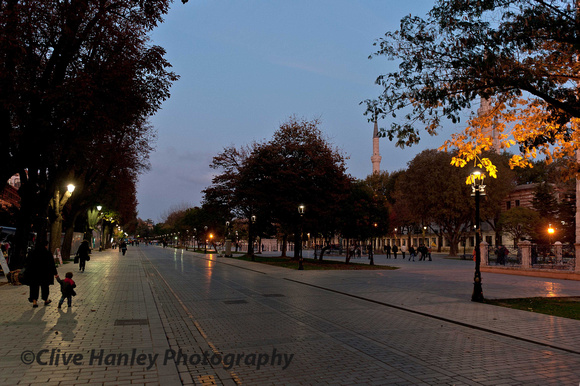The Hippodrome at Sultanahmet.
The Hippodrome of Constantinople was a circus that was the sporting and social centre of Constantinople, capital of the Byzantine Empire. Today it is a square named Sultanahmet Meydanı (Sultan Ahmet Square) in the Turkish city of Istanbul, with a few fragments of the original structure surviving. It is sometimes also called Atmeydanı (Horse Square) in Turkish.
Although the Hippodrome is usually associated with Constantinople's days of glory as an imperial capital, it actually predates that era. The first Hippodrome was built when the city was called Byzantium, and was a provincial town of moderate importance. In AD 203 the Emperor Septimius Severus rebuilt the city and expanded its walls, endowing it with a hippodrome, an arena for chariot races and other entertainment. In AD 324, the Emperor Constantine the Great decided to move the seat of the government from Rome to Byzantium, which he renamed Nova Roma (New Rome). This name failed to impress and the city soon became known as Constantinople, the City of Constantine. Constantine greatly enlarged the city, and one of his major undertakings was the renovation of the Hippodrome. It is estimated that the Hippodrome of Constantine was about 450 m (1,476 ft) long and 130 m (427 ft) wide. Its stands were capable of holding 100,000 spectators. The race-track at the Hippodrome was U-shaped, and the Kathisma (emperor's loge) was located at the eastern end of the track. The Kathisma could be accessed directly from the Great Palace through a passage which only the emperor or other members of the imperial family could use. The Hippodrome Boxes, which had four statues of horses in gilded copper on top, stood at the northern end; and the Sphendone (curved tribune of the U-shaped structure, the lower part of which still survives) stood at the southern end. These four gilded horses, now called the Horses of Saint Mark, whose exact Greek or Roman ancestry has never been determined, were looted during the Fourth Crusade in 1204 and installed on the façade of St Mark's Basilica in Venice. The track was lined with other bronze statues of famous horses and chariot drivers, none of which survive. The hippodrome was filled with statues of gods, emperors and heroes, among them some famous works, such as a Heracles by Lysippos, Romulus and Remus with their wolf and the Serpent Column of the Plataean tripod. In his book De Ceremoniis (book II,15, 589), the emperor Constantine Porphyrogenitus described the decorations in the hippodrome at the occasion of the visit of Saracen or Arab visitors, mentioning the purple hangings and rare tapestries. Constantinople never really recovered from its sack during the Fourth Crusade and even though the Byzantine Empire survived until 1453, by that time, the Hippodrome had fallen into ruin. The Ottoman Turks, who captured the city in 1453 and made it the capital of the Ottoman Empire, were not interested in racing and the Hippodrome was gradually forgotten, although the site was never actually built over.
The Hippodrome was used for various occasions such as the lavish and days-long circumcision ceremony of the sons of Sultan Ahmed III. (Owch!)


